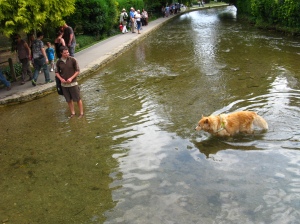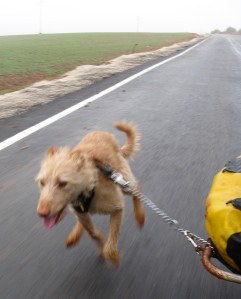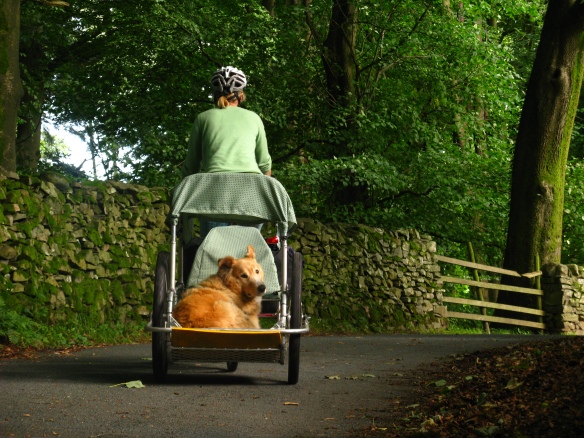In the summer of 2008 we sold whatever couldn’t fit on the back of our bikes and pedaled away from life as we knew it. Along with our two doggy co-pilots we have cycled over 17,000 miles (27,000 km), through 21 countries. Our adventures inspired us to write the children’s picture book series The Dog Detectives.
Jack
Jack is a gentle giant with a legendary appetite – over 40 kilos (90 pounds) of lovin’ from  which no food is safe – even lettuce! He is part Husky, part Border Collie, part Golden Retriever and his soft, fluffy golden coat attracts the pets of many strangers. Jack is the inspiration for Detective Jack.
which no food is safe – even lettuce! He is part Husky, part Border Collie, part Golden Retriever and his soft, fluffy golden coat attracts the pets of many strangers. Jack is the inspiration for Detective Jack.
Paco
In Czech Paco means crazy, and Paco enjoys living up to his name on a daily basis. Paco is a wild and scruffy dog with a powerful nose that can smell trouble from a mile away. He is a fast and clever Portuguese Podengo with a talent for solving problems. Paco is the inspiration for Deputy Poco.
Zoa
Zoa pulls 160 pounds of dog and supplies with a big smile. She holds the title of chief engineer due to her ingenious, and sometimes wacky ways of fixing problems. She believes most problems in life can be fixed with duct tape, lube and zip ties. Her favourite cycling is towards a steaming coffee.
Fin
Fin is an Australian boy with a love of music and meerkats. He runs on a highly combustible, vegetable powered engine. Fin is proud to hold the title of head of navigation due to being the only member of the team who can successfully read a map.
.
.Life on a Bike with Dogs – Questions & Answers
You are crazy! Why do you travel with your dogs by bicycle?
We had no volunteers to take on the care of two dogs (one very crazy) for a year, and giving them away was out of the question. We didn’t want to use the dogs as an excuse not to travel, so we found a way.
Do you recommend cycle touring with dogs?
It has its challenges and its rewards. No easy yes or no answer, but some things to think about:
- An obvious one, but a big one… it adds a lot of weight to your bicycle and makes cycling more strenuous. Dog food, extra water, leashes, basket/trailer, plus the dog adds up and will lower your speed and daily distances
- High speeds and long daily distances aren’t the be all and
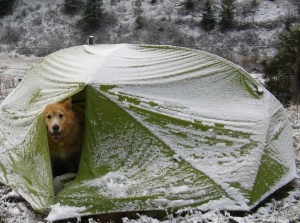 end all
end all - You will become fitter and build stronger muscles than the average Josephine
- You become a bit of a traveling circus and will be stared at
- It is a conversation starter, and an easy way to meet a lot of friendly people
- It limits which countries you can visit comfortably. Originally we were planning on going to Morocco and Middle East but because of the dogs and the problems we might encounter we were warned against it
- Dogs are great company and keep you humble
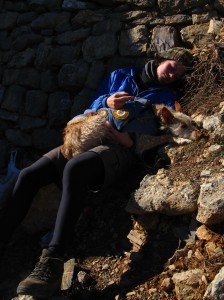
- It can be more awkward visiting museums/churches etc.
- You can change people’s perceptions of what is possible
- Sometimes when it is wet and cold you would love to go into a warm B&B and have a hot shower, but dogs aren’t allowed
- It makes public transport (ferries/trains/buses) a physical and logistical challenge and sometimes it is just impossible
- They can act as a hot water bottle when it’s cold
- Dogs can be security guards for your belongings
- Taking a hunting dog can into the wild can lead to a lot of barking and potentially a lot of frustration. (One time we had to wait three hours for Paco to return from a bunny chasing escapade)
What is the average kilometers you cycle a day?
Depends on the time of year, terrain: and weather. Winter approx 50km and Spring/Summer/Autumn 65km. Our longest day so far is 137km in New Mexico.
How many kilometers a day do the dogs run?
This depends on the road, steepness, and amount of traffic on the road. Sometimes 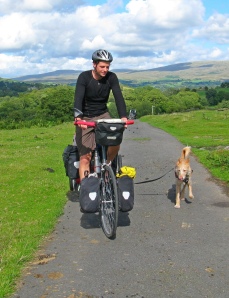 less than 1km; sometimes up to 6km on hilly days. Paco, the younger dog, runs more often. The dogs are good at telling us when they are tired – Paco just stops, Jack jumps in the trailer at any opportunity. I have heard of young and active dogs who can run up to 40km a day. It is about knowing what your dog is capable of so they don’t overdo it.
less than 1km; sometimes up to 6km on hilly days. Paco, the younger dog, runs more often. The dogs are good at telling us when they are tired – Paco just stops, Jack jumps in the trailer at any opportunity. I have heard of young and active dogs who can run up to 40km a day. It is about knowing what your dog is capable of so they don’t overdo it.
Do they pull you at all like huskies?
When they become overexcited by wildlife they can pull us pretty strongly. One time Paco once went mad on a 7km bunny chase. Fin didn’t really have to pedal the whole time.
How much luggage do you carry?
When fully loaded the bicycles carry between 60-70kg of dogs and luggage each.
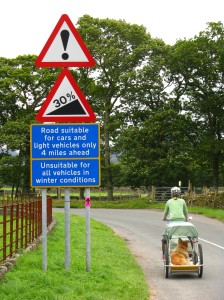 And what is it like cycling with them? It must be murder on the hills…
And what is it like cycling with them? It must be murder on the hills…
The extra weight is not so noticeable on the flat roads and once you get momentum it is relatively smooth sailing. Uphill is more of a challenge, (especially at first!) but becomes easier the more kilometers you clock. People often warn us of the mountains but we have never changed our route because of the weight. Our steepest ascent was an 33% grade (where our heads nearly exploded) and our highest pass was about 3121 metres in the Colorado. We rarely have to resort to pushing the bikes.
Trailers vs long-tail cargo bikes: Pros and Cons..
The trailer has extra rolling resistance from the two additional tires and is a dead weight to drag up hills. It is a bit of a challenge on unpaved surfaces (loose gravel/sand/mud) 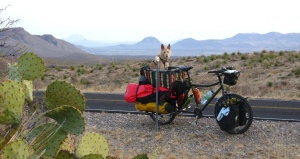 and has flipped a few times on some mountain biking trails. Ouch! The trailer we use has 2 wheels which creates 3 different tire tracks and makes it hard to avoid glass and roadside reflectors, and for poor snails it is a veritable chariot of death. Also the width of the trailer can be a challenge for getting through small gaps/fences etc. The upside is that the trailer has suffered less mechanical damaged than the longtail bike (Big Dummy) where the extra weight has contributed to cracked rims and damaged hubs (using a lot of pressure with Magura hydraulic brakes anyway). Back tires on both bikes take more of a pounding and the extra weight seems to contribute to more flat tires. Due to the extra length of the Big Dummy long-tail frame, the ride is less stable but you get used to it.
and has flipped a few times on some mountain biking trails. Ouch! The trailer we use has 2 wheels which creates 3 different tire tracks and makes it hard to avoid glass and roadside reflectors, and for poor snails it is a veritable chariot of death. Also the width of the trailer can be a challenge for getting through small gaps/fences etc. The upside is that the trailer has suffered less mechanical damaged than the longtail bike (Big Dummy) where the extra weight has contributed to cracked rims and damaged hubs (using a lot of pressure with Magura hydraulic brakes anyway). Back tires on both bikes take more of a pounding and the extra weight seems to contribute to more flat tires. Due to the extra length of the Big Dummy long-tail frame, the ride is less stable but you get used to it.
What type of bicycle trailer do you have?
Due to Jack’s weight we had to search for a trailer that was suitable for a 50kg dog. Most trailers are only strong enough for about 30 kilos/75 pounds. The trailer comes 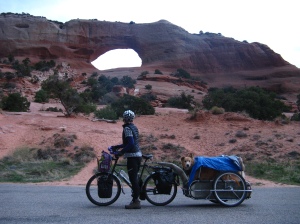 from CycleTote, an American company that specializes in bicycle trailers for disabled children and dogs. We have the largest dog trailer which is suitable for dogs up to 70kilos/150 pounds. They are a bit expensive but they are quality trailers (light weight aluminum, but strong). The trailers uses 26 inch or 28 inch bicycle wheels which is great as you can match it with the wheel size of your bicycle which means less backup tires and tubes you have to carry. The option of drum brakes is very handy on steep downhills with heavy loads. Twice we have required the trailer to be re-welded (one from the daily grind, one from a crash) and both times we were lucky enough to find an aluminum welder nearby.
from CycleTote, an American company that specializes in bicycle trailers for disabled children and dogs. We have the largest dog trailer which is suitable for dogs up to 70kilos/150 pounds. They are a bit expensive but they are quality trailers (light weight aluminum, but strong). The trailers uses 26 inch or 28 inch bicycle wheels which is great as you can match it with the wheel size of your bicycle which means less backup tires and tubes you have to carry. The option of drum brakes is very handy on steep downhills with heavy loads. Twice we have required the trailer to be re-welded (one from the daily grind, one from a crash) and both times we were lucky enough to find an aluminum welder nearby.
How old are the dogs, what breeds, what do they weigh?
Paco is a 6 year old Portuguese Podengo and weighs 16kg.
Jack is a 12 year old mutt (Golden Retriever/Husky/Collie cross) and weighs 40’sh kg.
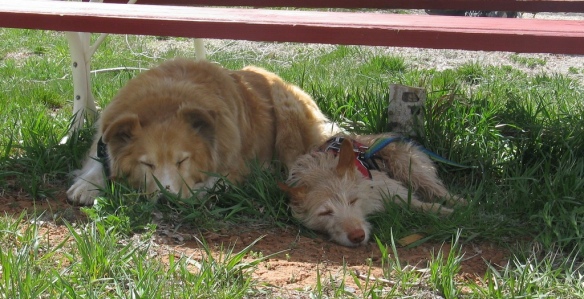 Do you carry dog food with you?
Do you carry dog food with you?
Yes, we have a waterproof Seal-Line bag that carries around 2kg of dog food. Although, it is more expensive, we try to get smaller bags of dog food to keep the weight down. They also get a few leftovers here and there and often receive tasty gifts from strangers.
We have a carrying capacity of 14 litres. 2 x 1.5 litre plastic bottles from the grocery store, 2 x 600 ml stainless steel water bottles and one 10 litre MSR dromedary bladder. Because free water is easy to find (i.e. Water fountains, gas stations, asking at cafes etc.) in Europe, we can usually get by just filling our water bottles up. Occasionally we also fill up the 10L Dromedary bladder when wild camping, especially if we have a cooking extravaganza or are off the beaten track. We often do our dishes during the day at a public fountain or gas station as well. Another option which we did not go for and worth looking into is a water filtration system.
Paperwork and Shots/Vaccinations – Taking dogs to Europe
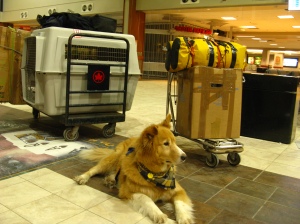 To enter the Schengen zone you have to have your dog’s rabies vaccination up-to-date, your dog must be micro-chipped, and you must have an international vet certificate from your home vet. For Sweden and Norway your dog must also have a blood test for rabies and be de-wormed for tapeworm, with the appropriate documentation. It is also wise to have medication for fleas and ticks. Consult your vet for country/region specific recommendations.
To enter the Schengen zone you have to have your dog’s rabies vaccination up-to-date, your dog must be micro-chipped, and you must have an international vet certificate from your home vet. For Sweden and Norway your dog must also have a blood test for rabies and be de-wormed for tapeworm, with the appropriate documentation. It is also wise to have medication for fleas and ticks. Consult your vet for country/region specific recommendations.
Can the dogs travel freely within the Schengen zone of Europe?
Almost. You must have a pet passport that documents your pet’s vaccinations etc. The only exception we have come across is Sweden and Norway which require a blood test for rabies and a de-worming within 10 days prior to arrival. However, in the year we have been traveling no one has asked about our documentation. Of course, ask your vet for the most up to date info.
What is the Schengen zone of Europe?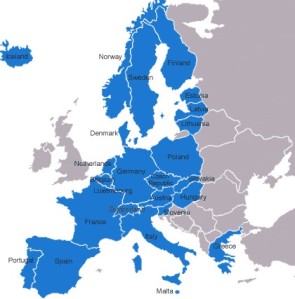
The Schengen agreement was a treaty signed for the removal of systematic border controls between the participating European countries. The Schengen countries include: Austria ,Belgium, Czech Republic, Denmark, Estonia, Finland, France, Germany, Greece, Hungary, Iceland Italy, Latvia, Lithuania, Luxembourg, Malta, Netherlands, Norway, Poland, Portugal, Slovakia, Slovenia, Spain, Sweden, Switzerland.
Have the dogs ever been sick or hurt?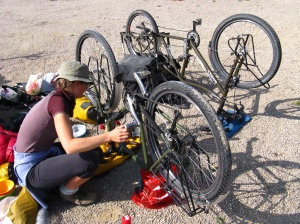
No, despite a few accidents there have been no injuries or illness. Jack, the big dog has a bit of arthritis but manages well enough.
What reaction do you get?
Some think it is cool, crazy or ridiculous, some think we are nutbags, most laugh. Young kids and middle aged French and Italian women (clapping and shouting ‘Bravo!’) are our biggest fans. Spain had the least favourable reaction. Many people stop to talk, ask questions, and take photos/video. On our tour across America the invitations for a meal and/or a place to stay were overwhelming. Overall extremely positive.
What happens if you want to go into a café/restaurant or a museum/church etc?
Normally, we sit outside at cafes if possible or we leave the dogs by the bicycles playing 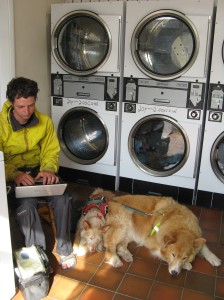 security guards/PR. For museums, galleries, churches, etc. we tend to take it in turns. One of us hangs out with the dogs and reads while the other goes inside for a look.
security guards/PR. For museums, galleries, churches, etc. we tend to take it in turns. One of us hangs out with the dogs and reads while the other goes inside for a look.
Is it easy to find accommodation with dogs?
Belgian, France, Holland and Germany, dogs are accepted into many hotels and B&B’s for an extra charge per night and are also allowed on trains. In Belgium and France, dogs are often accepted into restaurants and cafes. Most campgrounds throughout Europe accept dogs, ranging from 2-4 euro per do per night. Spain and Portugal are more difficult but in bigger cities some hotels accept dogs.
Where do the dogs sleep?
When the weather is warm enough, the big dog with the thick, warm coat sleeps outside under a tarp. The little one who gets cold very easily and thinks himself a prince sleeps in the tent.
Do the dogs get too cold or too hot?
Jack has a thick coat so the cold is not a problem. We try not to walk him too much on hot days. Paco has a couple of jackets for the cold weather and loves the heat. If it rains Jack usually ends up getting wet and Paco is content to hide under the cover on his basket to keep dry. So far, no problems, although we try to avoid temperature extremes.
Do you attach them to your bikes when you cycle? How?
Yes, both dogs wear a harness and Paco is attached by a short lead to the Big Dummy wide loaders, and Jack is attached to the trailer by a lead (which can be a bit dangerous as if he decides to stop he stop suddenly). If there is little traffic we let Jack walk beside us unattached.
Have you taken any trains or ferries?
Yes, we considered taking a train in Spain but they have a 6kg weight limit for dogs (that is big dog discrimination). In Slovenia we took a car-train when the road was blocked by a landslide. We were the only passengers late at night and the bumpy ride shook the hell out of bikes (luckily they were still in one piece at the other end). We also taken several trains and ferries in Germany and Scandinavia without any problems.
Do they enjoy it?
Absolutely! They alove taking in new sights and smells (especially reindeers) and they enjoy loads of exercise, company and attention. What more could a dog want?
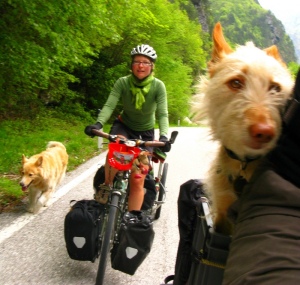 In the summer of 2008 we sold whatever couldn’t fit on the back of our bikes and pedaled away from life as we knew it. Along with our two doggy co-pilots we have cycled over 10,000 miles/17,000 kilometres (about half way around the world) through 20 countries. Along the way we have all kinds of curious creatures, and enjoyed the simple pleasures that are so easily overlooked in cluttered and hurried lives. Our bike adventures with our two dogs inspired us to write the children’s picture book series The Dog Detectives.
In the summer of 2008 we sold whatever couldn’t fit on the back of our bikes and pedaled away from life as we knew it. Along with our two doggy co-pilots we have cycled over 10,000 miles/17,000 kilometres (about half way around the world) through 20 countries. Along the way we have all kinds of curious creatures, and enjoyed the simple pleasures that are so easily overlooked in cluttered and hurried lives. Our bike adventures with our two dogs inspired us to write the children’s picture book series The Dog Detectives.
.
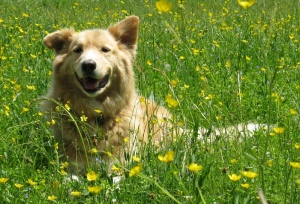 Jack
Jack
Jack is a gentle giant with a legendary appetite – over 40 kilos (90 pounds) of lovin’ from which no food is safe – even lettuce! He is part Husky, part Border Collie, part Golden Retriever and his soft, fluffy golden coat attracts the pets of many strangers. Jack is the inspiration for Detective Jack.
.
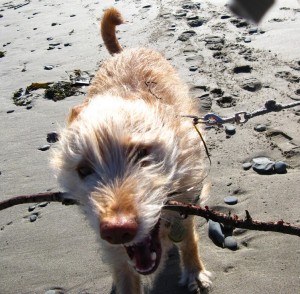 Paco
Paco
In Czech Paco means crazy, and Paco enjoys living up to his name on a daily basis. Paco is a wild and scruffy dog with a powerful nose that can smell trouble from a mile away. He is a fast and clever Portuguese Podengo with a talent for solving problems. Paco is the inspiration for Deputy Poco.
.
,
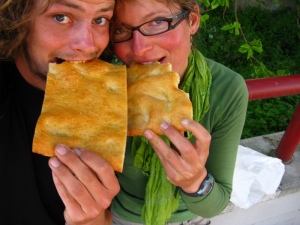 Fin & Zoa
Fin & Zoa
Hi! We are two odd socks who met in the dark of an Icelandic winter. Zoa is a muffin baking, marathon running, scarf knitting Canadian girl, while Fin is an Australian boy with a love of meerkats. Together we live our passions – travel, bikes, books and adventure – and are the authors behind The Dog Detectives.
.
Life on a Bike

Jack enjoying the Autumn leaves in Sweden
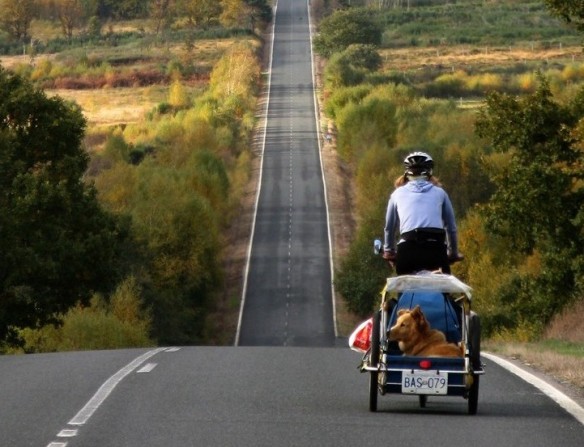
What goes down, must go straight back up: Jack and Zoa heading for Portugal
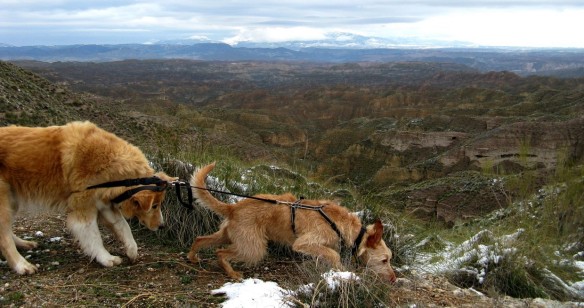
Jack and Paco sharing navigational differences in Spain

Paco in L A P P L A N D, Scandinavia
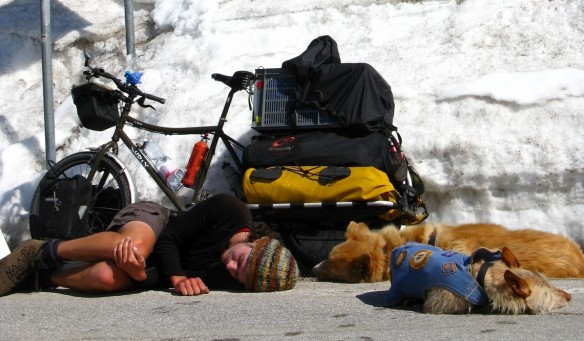
Fin, Jack and Paco enjoying a rest in the snow covered Italian Dolomites

Happy riding in Arctic Norway





